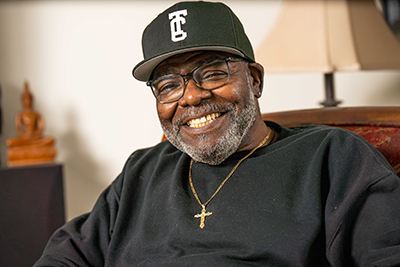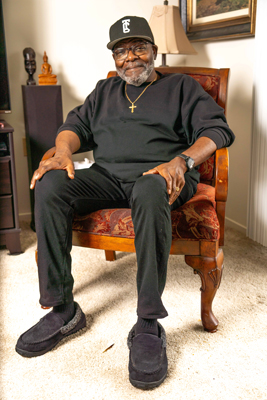Mr. Clay’s Story
After a heart attack, stents and more than 20 years of medication, Mr. Clay received a critical diagnosis and an LVAD implant, which gave him a new lease on life.
 Tony Clay was getting his kids ready for school one morning, when something felt very wrong.
Tony Clay was getting his kids ready for school one morning, when something felt very wrong.
He had already been taking over-the-counter medication for what felt like indigestion. But then he started experiencing some chest pain and shortness of breath. Suddenly, he had a strange sensation in his left arm.
“It felt almost like an electric shock,” Mr. Clay says. “I took the kids to school, then came back home and called my PCP at Henry Ford and was connected with a nurse.” His symptoms got worse, and he threw up, then felt really hot, running water on the back of his neck to try to cool down.
After telling the nurse his symptoms she told him, “Mr. Clay, you need to sit down, it sounds like you’ve had a heart attack.” She also told him to call 911.
EMS came and rushed him to the nearest hospital, where tests showed that he was in congestive heart failure. Two of his coronary arteries were blocked almost completely. The hospital team placed stents in the arteries, and put Mr. Clay on heart medication.
“I was just 40, so this was a total shock to me,” he says.
While some people in his family had suffered strokes, Mr. Clay had no family history of heart disease. He did, however, have diabetes. And he was a smoker. Both of which may increase a person’s risk for developing heart disease.
“I also wasn’t eating as healthy as I should have,” Mr. Clay says. “I was still trying to enjoy life the way I was used to, and I think it took its toll. I even tried to continue smoking after the heart attack, but I had to quit one day, I just threw them into the trash.”
Despite his efforts to make healthy changes, his cardiologist had to keep increasing the dosage of Mr. Clay’s medication over the years, with his blood pressure medication alone increasing from 20 to 200 mg. During this time, he also had to go back in and have a second procedure to unblock one of the stents.
After a heart attack, stents and more than 20 years of medication, Mr. Clay received a critical diagnosis and an LVAD implant, which gave him a new lease on life.
More than 20 years after having his heart attack, Mr. Clay’s cardiologist told him that his heart wasn’t pumping as much as it should be, and recommended that he see Celeste Williams, M.D., an advanced heart failure specialist at Henry Ford.
 He scheduled the appointment at Henry Ford, and the day before, Mr. Clay and his wife were out having lunch.
He scheduled the appointment at Henry Ford, and the day before, Mr. Clay and his wife were out having lunch.
“All of a sudden, I passed out,” he says. “The next thing I know, there’s a crowd of people around me, including two retired EMTs. Since I’m diabetic, my wife and I thought it was low blood sugar. Especially since after I had some orange juice, I came back. So I didn’t go to the emergency room.”
The next day at his appointment with Dr. Williams at Henry Ford Hospital, she ran a series of tests. The numbers were not great.
“She told me that the severity of my heart condition had increased, and my heart wasn’t functioning as it should be,” Mr. Clay says.
The left side of his heart, which had been damaged in the initial heart attack, had gotten much worse over the years, despite the increase in medication. His heart was only beating at about 14 percent of its capacity. Dr. Williams recommended that he be admitted immediately and have a left ventricular assist device (LVAD) implanted.
“This was a shock,” Mr. Clay says. “I had driven myself there, and had no idea that I would have to stay. I asked the question, ‘What would happen if I didn’t get the LVAD right away, how long would I have?’”
The answer: Only a month or two.
After letting this news sink in, Mr. Clay opted to have the procedure, which involves placing a mechanical device on the left side of the heart. The LVAD helps a weakened heart pump blood to the rest of the body.
Both before his procedure and during his recovery, the Henry Ford care team showed Mr. Clay the LVAD unit, and walked him through how it works and how to take care of it.
“The system uses two batteries during the day, and at night you need to plug the unit into the wall socket for electric power,” Mr. Clay says. “I also needed to have a dedicated electric switch for use when I’m not on battery power. The system came with four sets of two batteries, a battery charger and a twenty-five-foot cord to move about, and I carry extra batteries whenever I go out. I also needed to be registered with my local fire department as well as within four hours of my hospital at all times, just in case I get the call that they have a heart. I’m also on blood thinners and have some dietary restrictions, and I can’t shower or get the unit wet. It was a big change, and a lot of information to digest.”
At first, it was scary, and Mr. Clay and his family needed to get used to it.
“I would lay down and look at this drive line thing going inside me, and it was really a challenge,” Mr. Clay says. “I worried about getting up, and hoping the cord wouldn’t be tangled. I had trouble sleeping, especially listening to the pump working. I learned to not sleep on my left side. I also had a lot of ‘what if’ moments. What if it stopped working?”
“The first time our power went out, my wife was working on one of her projects, and I was sleeping in the other bedroom,” Mr. Clay says. “I woke up when I heard a loud beeping sound. It sounded like the emergency broadcast testing they do on TV. I had the remote in my hand, so I tried to turn off the TV. My wife ran in and told me, ‘that’s you, not the TV,’ and we both rushed around to get me back on batteries until the power came back on.”
Mr. Clay’s children, now grown, have also been there supporting him throughout his journey.
“They think the LVAD is an amazing piece of work,” he says. “And they try to help me any way they can, like checking on me daily to make sure I’m all right. I tell them I don’t want to be a burden and I’m going to be alright, because they have their own lives to live. When I try to do a ‘what if’ about my future, they tell me, ‘Shut up Pop, you’re going to be OK.’”
While it’s been an adjustment for everyone, it has been worth it. Mr. Clay notices the huge difference that the LVAD makes. He has more energy and no longer has to deal with symptoms like shortness of breath.
 In the 5 and a half years that followed, Mr. Clay came to terms with the LVAD lifestyle. Retired from the City of Detroit, he found new purpose helping to train medical students in the Standardized Patient Program at Wayne State University and continued to find joy in life with wife Toni, four children and nine grandchildren.
In the 5 and a half years that followed, Mr. Clay came to terms with the LVAD lifestyle. Retired from the City of Detroit, he found new purpose helping to train medical students in the Standardized Patient Program at Wayne State University and continued to find joy in life with wife Toni, four children and nine grandchildren.
Then one Monday, he went to Henry Ford Hospital for weekly blood work, and a scheduled examination. But on the way home, he received a phone call., “Tony? Are you still in the hospital? No? Well, can you come back. Your hemoglobin is very low.” Ordered by the nurse on the phone not to drive himself, he found a ride and headed back to Detroit. Unexplained blood loss led to a month of testing and observation until one night a blood clot momentarily stopped his LVAD pump! After this event, the medical team made it clear that he wasn’t leaving the hospital without a heart transplant.
During a moment of despair and frustration, which can be common while waiting for a transplant, one of the Henry Ford Hospital nurses visited Mr. Clay’s room. During their conversation, she pointed to the floor and said, “Look!” The power cord from his LVAD had fallen into the shape of a heart on the floor! She said, “This is a sign… You’re going to get a heart!” Two weeks later, the phone rang. The voice on the other end was LVAD coordinator Jacquelina Borgula, “I’ve got something for you.” After a short pause she defined “something.” The words he’d been waiting 5 years to hear, “I’ve got a heart for you!” Mr. Clay recalls, “I’m like.. WHAT? I started shakin’… I didn’t know what say… I was in tears… Who do I call? I couldn’t sleep!” The next morning, he went into surgery, “The last thing I remember was rolling into the operating room and seeing all the people and all the equipment. The next thing was someone waking me up and my daughter saying, ‘Do you know what day this is? It’s Good Friday.’” Mr. Clay remains convinced to this day that the signs leading up to his transplant and its eventual success are the work of a much higher power.
Mr. Clay recalls the incredible staff who guided him on this journey, including cardiologists Celeste Williams, M.D., Jennifer Cowger, M.D., Christina Tita, M.D., Yelena Selektor, M.D., and his surgeon, Kyle Miletic, M.D. One of the greatest forces in his transplant journey, though, was Transplant Coordinator Geralyn Trombley, “She has a voice that could calm the average bull. No matter how frustrated or angry I was, she could speak and calm me right down.”
“It's amazing, when you lay down at night, and you can hear this heart beating inside you… I’m so grateful… You find this new appreciation for life… And all the little things. You realize that God gave you a second chance, and you just want to do right by people… It’s just a beautiful feeling to be alive!”
In the future, Mr. Clay hopes to meet and thank his heart donor’s family and return to his work helping medical students at Wayne State. Meanwhile, he reminds us all, “Let go of the past, appreciate the present, and continue to have faith.”
We use cookies to improve your website experience. By using this site, you agree to our Terms of Use. Read our Internet Privacy Statement to learn what information we collect and how we use it.